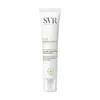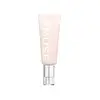What's inside
What's inside
 Key Ingredients
Key Ingredients

 Benefits
Benefits

 Concerns
Concerns

 Ingredients Side-by-side
Ingredients Side-by-side

Water
Skin ConditioningDimethicone
EmollientCI 77891
Cosmetic ColorantCaprylyl Methicone
Skin ConditioningNiacinamide
SmoothingPEG-10 Dimethicone
Skin ConditioningDiphenyl Dimethicone
EmollientPropylene Glycol
HumectantPEG/PPG-18/18 Dimethicone
EmulsifyingNeopentyl Glycol Diheptanoate
EmollientCI 77492
Cosmetic ColorantBoron Nitride
AbsorbentLauroyl Lysine
Skin ConditioningCetearyl Dimethicone Crosspolymer
Disteardimonium Hectorite
StabilisingPropylene Carbonate
SolventSaccharide Isomerate
HumectantSalicylic Acid
MaskingCitric Acid
BufferingSodium Citrate
BufferingSodium Hydroxide
BufferingTriethoxycaprylylsilane
Parfum
MaskingCI 77491
Cosmetic ColorantCI 77499
Cosmetic ColorantWater, Dimethicone, CI 77891, Caprylyl Methicone, Niacinamide, PEG-10 Dimethicone, Diphenyl Dimethicone, Propylene Glycol, PEG/PPG-18/18 Dimethicone, Neopentyl Glycol Diheptanoate, CI 77492, Boron Nitride, Lauroyl Lysine, Cetearyl Dimethicone Crosspolymer, Disteardimonium Hectorite, Propylene Carbonate, Saccharide Isomerate, Salicylic Acid, Citric Acid, Sodium Citrate, Sodium Hydroxide, Triethoxycaprylylsilane, Parfum, CI 77491, CI 77499
Water
Skin ConditioningDibutyl Adipate
EmollientButylene Glycol
HumectantPropanediol
SolventTitanium Dioxide
Cosmetic ColorantGlycerin
HumectantPolyglyceryl-3 Methylglucose Distearate
EmulsifyingC12-15 Alkyl Benzoate
AntimicrobialNiacinamide
SmoothingPhenyl Trimethicone
Skin ConditioningPolysilicone-15
UV FilterMethylpropanediol
SolventTridecyl Trimellitate
Emollient1,2-Hexanediol
Skin ConditioningCetearyl Alcohol
EmollientEthylhexyl Triazone
UV AbsorberPanthenol
Skin ConditioningPentylene Glycol
Skin ConditioningPolysorbate 60
EmulsifyingPrunus Persica Fruit Extract
AbrasiveSimmondsia Chinensis Seed Oil
EmollientSodium Hyaluronate
HumectantBis-Ethylhexyloxyphenol Methoxyphenyl Triazine
Skin ConditioningGlyceryl Stearate
EmollientPolymethylsilsesquioxane
Polyglyceryl-2 Caprate
EmulsifyingPalmitic Acid
EmollientPolyacrylate Crosspolymer-6
Emulsion StabilisingPolyacrylate-13
Ammonium Acryloyldimethyltaurate/Vp Copolymer
Sucrose Stearate
EmollientEthylhexylglycerin
Skin ConditioningPolyisobutene
Sodium Stearoyl Glutamate
CleansingStearic Acid
CleansingAlumina
AbrasiveXanthan Gum
EmulsifyingSaccharomyces Ferment Filtrate
HumectantAdenosine
Skin ConditioningGlyceryl Caprylate
EmollientDisodium EDTA
Squalane
EmollientPolysorbate 20
EmulsifyingSorbitan Isostearate
EmulsifyingT-Butyl Alcohol
PerfumingDimethylsilanol Hyaluronate
HumectantHydrolyzed Sodium Hyaluronate
Skin ConditioningHydrolyzed Hyaluronic Acid
HumectantMyristic Acid
CleansingPotassium Hyaluronate
Skin ConditioningHyaluronic Acid
HumectantSodium Hyaluronate Crosspolymer
HumectantHydroxypropyltrimonium Hyaluronate
Sodium Hyaluronate Dimethylsilanol
HumectantSodium Acetylated Hyaluronate
HumectantTocopherol
AntioxidantParfum
MaskingCI 77492
Cosmetic ColorantCI 77491
Cosmetic ColorantCI 77499
Cosmetic ColorantWater, Dibutyl Adipate, Butylene Glycol, Propanediol, Titanium Dioxide, Glycerin, Polyglyceryl-3 Methylglucose Distearate, C12-15 Alkyl Benzoate, Niacinamide, Phenyl Trimethicone, Polysilicone-15, Methylpropanediol, Tridecyl Trimellitate, 1,2-Hexanediol, Cetearyl Alcohol, Ethylhexyl Triazone, Panthenol, Pentylene Glycol, Polysorbate 60, Prunus Persica Fruit Extract, Simmondsia Chinensis Seed Oil, Sodium Hyaluronate, Bis-Ethylhexyloxyphenol Methoxyphenyl Triazine, Glyceryl Stearate, Polymethylsilsesquioxane, Polyglyceryl-2 Caprate, Palmitic Acid, Polyacrylate Crosspolymer-6, Polyacrylate-13, Ammonium Acryloyldimethyltaurate/Vp Copolymer, Sucrose Stearate, Ethylhexylglycerin, Polyisobutene, Sodium Stearoyl Glutamate, Stearic Acid, Alumina, Xanthan Gum, Saccharomyces Ferment Filtrate, Adenosine, Glyceryl Caprylate, Disodium EDTA, Squalane, Polysorbate 20, Sorbitan Isostearate, T-Butyl Alcohol, Dimethylsilanol Hyaluronate, Hydrolyzed Sodium Hyaluronate, Hydrolyzed Hyaluronic Acid, Myristic Acid, Potassium Hyaluronate, Hyaluronic Acid, Sodium Hyaluronate Crosspolymer, Hydroxypropyltrimonium Hyaluronate, Sodium Hyaluronate Dimethylsilanol, Sodium Acetylated Hyaluronate, Tocopherol, Parfum, CI 77492, CI 77491, CI 77499
 Reviews
Reviews

Ingredients Explained
These ingredients are found in both products.
Ingredients higher up in an ingredient list are typically present in a larger amount.
Ci 77491 is also hydrated iron III oxide. It's sole purpose is to give a red/pink hue to products.
Iron III oxides are classified as inorganic chemicals for coloring.
Synthetically created Ci 77491 is considered safer than those naturally found. This is because the synthetically created version may contain less impurities. Iron oxides are generally non-toxic and non-allergenic.
Learn more about CI 77491Ci 77492 is also hydrated iron III oxide. It's sole purpose is to give a yellow hue to products.
Iron III oxides are classified as inorganic chemicals for coloring.
Synthetically created Ci 77492 is considered safer than those naturally found. This is because the synthetically created version may contain less impurities. Iron oxides are generally non-toxic and non-allergenic.
Learn more about CI 77492Ci 77499 is also hydrated iron III oxide. It is created from mixing red and black iron oxides. This helps give shades of darkness to a product.
Iron III oxides are classified as inorganic chemicals for coloring.
Niacinamide is a multitasking form of vitamin B3 that strengthens the skin barrier, reduces pores and dark spots, regulates oil, and improves signs of aging.
And the best part? It's gentle and well-tolerated by most skin types, including sensitive and reactive skin.
You might have heard of "niacin flush", or the reddening of skin that causes itchiness. Niacinamide has not been found to cause this.
In very rare cases, some individuals may not be able to tolerate niacinamide at all or experience an allergic reaction to it.
If you are experiencing flaking, irritation, and dryness with this ingredient, be sure to double check all your products as this ingredient can be found in all categories of skincare.
When incorporating niacinamide into your routine, look out for concentration amounts. Typically, 5% niacinamide provides benefits such as fading dark spots. However, if you have sensitive skin, it is better to begin with a smaller concentration.
When you apply niacinamide to your skin, your body converts it into nicotinamide adenine dinucleotide (NAD). NAD is an essential coenzyme that is already found in your cells as "fuel" and powers countless biological processes.
In your skin, NAD helps repair cell damage, produce new healthy cells, support collagen production, strengthen the skin barrier, and fight environmental stressors (like UV and pollution).
Our natural NAD levels start to decline with age, leading to slower skin repair, visible aging, and a weaker skin barrier. By providing your skin niacinamide, you're recharging your skin's NAD levels. This leads to stronger, healthier, and younger looking skin.
Another name for vitamin B3 is nicotinamide. This vitamin is water-soluble and our bodies don't store it. We obtain Vitamin B3 from either food or skincare. Meat, fish, wheat, yeast, and leafy greens contain vitamin B3.
The type of niacinamide used in skincare is synthetically created.
Learn more about NiacinamideParfum is a catch-all term for an ingredient or more that is used to give a scent to products.
Also called "fragrance", this ingredient can be a blend of hundreds of chemicals or plant oils. This means every product with "fragrance" or "parfum" in the ingredients list is a different mixture.
For instance, Habanolide is a proprietary trade name for a specific aroma chemical. When used as a fragrance ingredient in cosmetics, most aroma chemicals fall under the broad labeling category of “FRAGRANCE” or “PARFUM” according to EU and US regulations.
The term 'parfum' or 'fragrance' is not regulated in many countries. In many cases, it is up to the brand to define this term.
For instance, many brands choose to label themselves as "fragrance-free" because they are not using synthetic fragrances. However, their products may still contain ingredients such as essential oils that are considered a fragrance by INCI standards.
One example is Calendula flower extract. Calendula is an essential oil that still imparts a scent or 'fragrance'.
Depending on the blend, the ingredients in the mixture can cause allergies and sensitivities on the skin. Some ingredients that are known EU allergens include linalool and citronellol.
Parfum can also be used to mask or cover an unpleasant scent.
The bottom line is: not all fragrances/parfum/ingredients are created equally. If you are worried about fragrances, we recommend taking a closer look at an ingredient. And of course, we always recommend speaking with a professional.
Learn more about ParfumWater. It's the most common cosmetic ingredient of all. You'll usually see it at the top of ingredient lists, meaning that it makes up the largest part of the product.
So why is it so popular? Water most often acts as a solvent - this means that it helps dissolve other ingredients into the formulation.
You'll also recognize water as that liquid we all need to stay alive. If you see this, drink a glass of water. Stay hydrated!
Learn more about Water